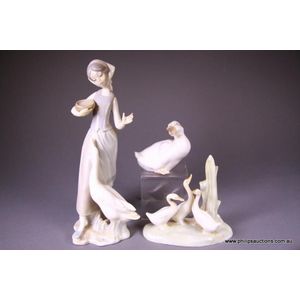Geisha Inlaid Wood Panel, 1860
You must be a subscriber, and be logged in to view price and dealer details.
Subscribe Now to view actual auction price for this item
When you subscribe, you have the option of setting the currency in which to display prices to $Au, $US, $NZ or Stg.
- Ivory - Ivory is a hard white material that comes from the tusks of elephants, mammoth, walrus and boar, or from the teeth of hippopotamus and whales. The ivory from the African elephant is the most prized source of ivory. Although the mammoth is extinct, tusks are still being unearthed in Russia and offered for sale.
Ivory has been used since the earliest times as a material for sculpture of small items, both in Europe and the east, principally China and Japan.
In Asia ivory has been carved for netsuke, seals, okimono, card cases, fan supports, animals and other figures and even as carved tusks.
In the last 200 years in Europe ivory has been used to carve figures, for elaborate tankards, snuff boxes, cane handles, embroidery and sewing accessories, in jewellery and as inlay on furniture. Its more practical uses include being used for billiard balls, buttons, and a veneers on the top of piano keys.
The use and trade of elephant ivory have become controversial because they have contributed to Due to the decline in elephant populations because of the trade in ivory, the Asian elephant was placed on Appendix One of the Convention on International Trade in Endangered Species (CITES), in 1975, and in January 1990, the African elephant was similarly listed. Under Appendix One, international trade in Asian or African elephant ivory between member countries is forbidden. Unlike trade in elephant tusks, trade in mammoth tusks is legal.
Since the invention of plastics, there have been many attempts to create an artificial ivory - Mother-Of-Pearl - Mother-of-pearl, technical name "nacre", is the inner layer of a sea shell. The iridescent colours and strength of this material were widely used in the nineteenth century as an inlay in jewellery, furniture, (especially papier mache furniture) and musical instruments.
In the early 1900s it was used to make pearl buttons. Mother-of-pearl is a soft material that is easily cut or engraved.
Nowadays it is a by-product of the oyster, freshwater pearl mussel and abalone industries.
This item has been included into following indexes:
Visually similar items

Two porcelain figurines, Lladro and Nao, later 20th century, in the typical Lladro and Nao palette of muted blue greys and mushroom, both figurines depicting young women in long skirts and headscarfs each accompanied by a goose; backstamps to both undersid

An alabaster and marble female bust, circa 1900. 'Sapho' (sic), the bust of the serene classical figure with a painted laurel garland about her tied hair and raised on a tapering rectangular mottled marble base marked 'Sapho' in distinctive lettering in re

A group of three Lladro & Nao figurines, later 20th century, including 'Girl with Duck' pattern #1052 issued in 1969 and retired in 1998 designed by Vincente Martinez; and two Nao figurines by Lladro of a duck and a group of ducks or geese on a green base;

An Italian marble figure group on Socle modelled as a mother and child embracing, signed, 45 cm high
